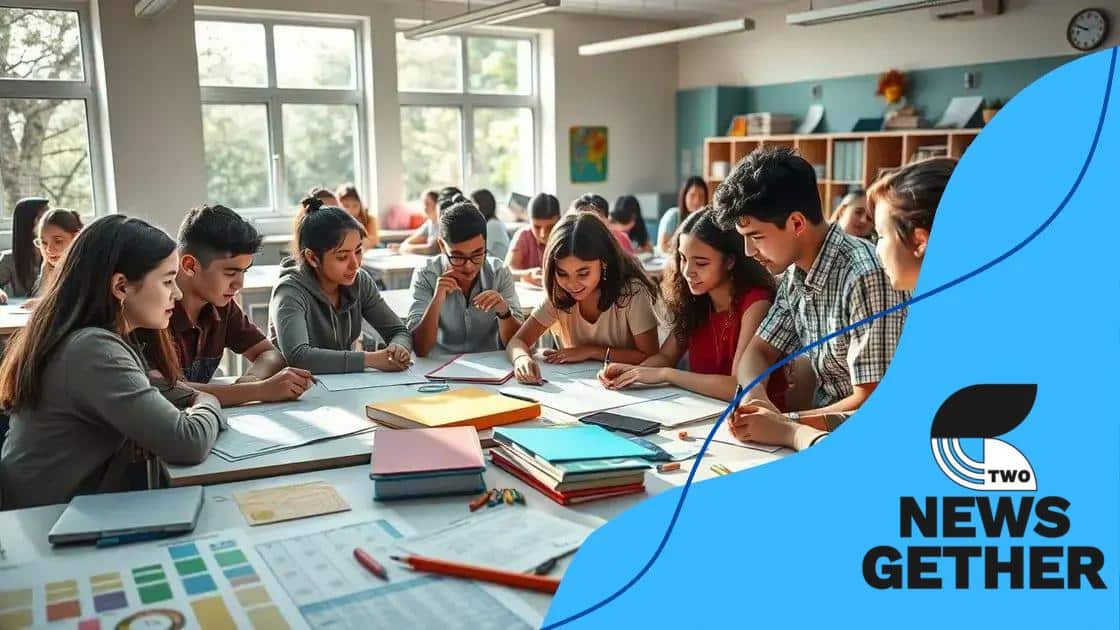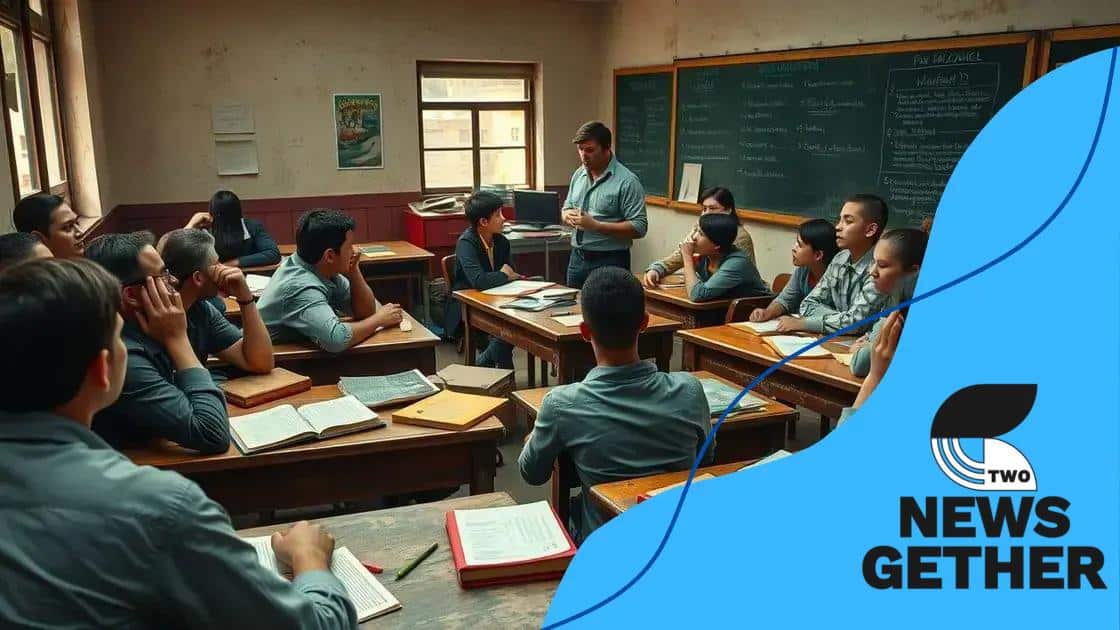The shift towards project-based learning in schools

The shift towards project-based learning in schools enhances student engagement and critical thinking by involving them in real-world projects that promote collaboration and problem-solving skills.
The shift towards project-based learning in schools is reshaping educational experiences for students. Have you noticed how engaging real-world projects can spark curiosity and deepen understanding? Let’s explore this exciting approach together.
Understanding project-based learning
Understanding project-based learning is essential for educators and students alike. This method focuses on engaging students in real-world projects that promote deeper learning. By incorporating this approach, schools can foster a more active and dynamic educational environment.
What is Project-Based Learning? Project-based learning (PBL) is a teaching strategy where students learn by actively engaging in projects. These projects are complex assignments that require critical thinking, collaboration, and communication. Unlike traditional methods, PBL encourages students to take charge of their learning.
Key Elements of Project-Based Learning
There are several elements that define effective project-based learning:
- Real-world relevance: Projects connect to real-life situations and problems.
- Student choice: Learners have the freedom to choose their project topics.
- Collaboration: Students often work in groups, enhancing teamwork skills.
- Reflection: Throughout the project, students reflect on their learning and process.
Another crucial aspect of project-based learning is assessment. It not only focuses on the final product but also on the process students undergo to complete their projects. Teachers often use formative assessments to monitor student progress during the project. This feedback helps students refine their work and deepen their understanding.
Incorporating technology can also enrich the project-based learning experience. Tools like video editing software, coding platforms, and collaborative online spaces can help students express their ideas creatively. Moreover, these resources prepare students for future careers where technology plays a vital role.
The Role of the Teacher
Teachers play a significant role in guiding students throughout their projects. Instead of traditional lecturing, they become facilitators, helping students navigate challenges and encouraging critical thinking. This shift transforms the classroom dynamic, resulting in a more engaging learning experience.
Overall, understanding project-based learning provides valuable insights for educators looking to innovate their teaching methods. By embracing this approach, schools can create engaging and meaningful educational experiences that empower students to thrive in a complex world.
The benefits of project-based learning
Understanding the benefits of project-based learning can transform how educators approach teaching. This educational strategy not only enhances learning but also fosters essential life skills in students. When students engage in hands-on projects, they become more invested in their education.
One of the main advantages of project-based learning is that it encourages critical thinking. Students are tasked with solving real-world problems, which helps develop their analytical skills. This process requires them to evaluate information, consider various solutions, and make informed decisions.
Engagement and Motivation
Projects make learning more engaging and enjoyable. Students are not just passively receiving information; they are actively involved in their own learning experiences. When students see how their work applies to the real world, they are often more motivated to learn.
- Increased curiosity: Students ask more questions when they are involved in projects.
- Ownership of learning: Students take responsibility for their learning outcomes.
- Improved collaboration: Group projects strengthen teamwork abilities.
Furthermore, project-based learning enhances communication skills. Students must present their projects, leading them to articulate their ideas clearly. This practice prepares them for future endeavors where effective communication is crucial.
Another significant benefit is that it caters to various learning styles. Some students thrive when they can engage in practical, hands-on activities. Others may prefer visual elements. Project-based learning allows for this diversity by incorporating different formats and approaches into a single project.
Preparation for the Future
Through project-based learning, students also gain skills that are important in the workplace. These include time management, creativity, and problem-solving abilities. In an ever-evolving job market, these skills are essential for future success.
Ultimately, understanding the benefits of project-based learning reveals its potential to create deeper, more meaningful educational experiences. With these benefits, educators can prepare students not just academically, but also socially and emotionally.
Challenges faced in implementation

Implementing project-based learning can bring numerous advantages, but it also presents several challenges that educators must address. Understanding these challenges is crucial for successful adoption and application in classrooms.
One significant obstacle is the resistance to change. Many educators are accustomed to traditional teaching methods, which can make them hesitant to shift to a new approach. They may fear that project-based learning will require more effort or lead to disorganization in the classroom.
Resource Limitations
Another challenge revolves around resources. Schools may lack the necessary materials or funding to support project-based initiatives. This limitation can restrict the kinds of projects that teachers want to implement. It’s essential to find creative solutions that allow projects to succeed even in resource-limited environments.
- Budget constraints: Limited funding can hinder project development.
- Availability of technology: Access to computers and software is often necessary.
- Time management: Teachers may struggle to find time within the curriculum for projects.
Teacher training also plays a vital role in effective implementation. Educators need proper training to understand how to facilitate project-based learning effectively. Without adequate professional development, teachers may feel overwhelmed, leading to a lack of confidence in executing this teaching method.
Additionally, assessing student progress during projects can be complex. Unlike traditional tests, project assessments require more nuanced evaluation methods. Teachers must develop clear criteria and tools to measure student learning accurately while providing constructive feedback throughout the project.
Student Engagement and Group Dynamics
Engaging all students in group projects can also be challenging. Some students may dominate discussions, while others may remain passive. It’s crucial for teachers to foster a collaborative environment where every student’s voice is heard.
By addressing these challenges head-on, educators can enhance the implementation of project-based learning in their classrooms. Embracing these obstacles creates opportunities for growth, both for teachers and students alike.
Strategies for successful project-based learning
To achieve successful project-based learning, educators can implement several effective strategies. These strategies help create an engaging and productive environment for students as they navigate their projects.
One primary strategy is to start with a clear project goal. Educators should define what students will learn and accomplish by the end of the project. This clarity ensures that students remain focused and understand the expectations.
Planning and Preparation
Proper planning is another key element. Teachers should take the time to design projects thoughtfully, incorporating relevant resources and timelines. This preparation allows for smooth execution and helps avoid potential roadblocks during the project.
- Involve students in the planning: Allowing students to contribute ideas can increase their engagement.
- Set milestones: Breaking projects into smaller steps can make them less overwhelming.
- Identify necessary resources: Gathering materials and tools ahead of time is crucial.
Another important aspect is to integrate assessments throughout the project. This formative assessment allows educators to monitor student progress and make adjustments if needed. Providing feedback during the project keeps students motivated and helps them stay on track.
Additionally, fostering collaboration among students is essential. Group work encourages them to share ideas, delegate tasks, and learn from each other. This collaboration enhances their communication and teamwork skills, which are vital in today’s world.
Emphasizing Reflection
After completing a project, it is important for students to reflect on their experiences. This reflection can help solidify their learning and allow them to identify what worked well and what could be improved for future projects. Teachers can facilitate this by asking guiding questions and encouraging open discussions.
Utilizing technology can also enhance project-based learning. Various tools and platforms can aid collaboration, research, and presentation. For example, students can use online forums to share ideas or utilize presentation software to showcase their final products.
By implementing these strategies, educators can create a rich and fulfilling project-based learning experience. Encouraging a structured yet flexible approach fosters student growth and prepares them for future endeavors.
Future trends in project-based education
Future trends in project-based education indicate a shift toward more personalized and technology-enhanced learning experiences. As education continues to evolve, these trends will play a crucial role in shaping how students engage with their learning.
One significant trend is the integration of technology into project-based learning. Educators are increasingly using digital tools to facilitate collaboration, research, and presentations. This technology provides students with access to a wealth of resources and enhances their ability to connect with experts and peers worldwide.
Personalized Learning Experiences
Another essential development is the focus on personalized learning. Teachers are recognizing that each student has unique interests and abilities. This trend encourages educators to tailor projects to individual students, promoting greater engagement and motivation. Personalization can lead to more meaningful learning outcomes as students connect their projects to their interests.
- Flexible project topics: Allowing students to choose their project subjects increases ownership.
- Differentiated instruction: Adapting projects to meet diverse learning needs.
- Individual goal setting: Encouraging students to set personal learning objectives.
Collaboration is also becoming more pronounced in project-based education. Schools are forming partnerships with local organizations, businesses, and community members to provide real-world context for projects. These partnerships not only enrich student learning but also strengthen community ties.
Sustainability and global awareness are increasingly influencing project themes. In a world facing complex social and environmental issues, educators are encouraging students to tackle relevant problems. This focus helps students become more socially responsible and prepares them for future challenges.
Emphasis on Social-Emotional Learning
Furthermore, future trends will prioritize social-emotional learning within project-based education. Teachers will aim to cultivate students’ emotional intelligence by focusing on cooperation and empathy during group projects. This emphasis on soft skills is increasingly understood as vital for success in academic and professional settings.
By staying attuned to these trends, educators can fully realize the potential of project-based education and prepare students for the future. Embracing technology, personalization, and collaboration will create engaging and relevant learning experiences for all students.
FAQ – Frequently Asked Questions about Project-Based Learning
What is project-based learning?
Project-based learning is an educational approach that engages students in real-world and meaningful projects to enhance their learning experience.
How does project-based learning benefit students?
It fosters critical thinking, collaboration, and engagement, helping students develop essential skills for the future.
What challenges do teachers face when implementing project-based learning?
Teachers may encounter resistance to change, resource limitations, and the need for effective assessment methods.
What are the future trends in project-based education?
Future trends include increased use of technology, personalized learning experiences, and a focus on social-emotional skills.






